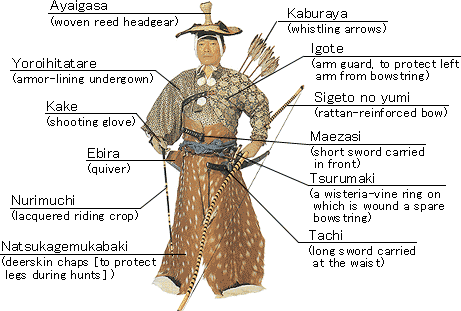It is a little known fact that before the samurai of ancient Japan incorporated the sword into their martial arts training, the samurai practiced the classical fighting arts of the bow. The Japanese martial art of shooting a bow with incredible accuracy while on horseback became known among the samurai as "The Way of the Horse and Bow". In the true fashion of the Japanese culture, they no doubt took a cue from the Mongolians and improved what another culture had to offer.
The bow has become a ritual rather than a practical instrument in Japanese martial arts training. Introduced to the culture in ancient times, it was different from the European bow from which it was derived. The main difference is the handgrip.
In Japanese classical fighting arts, the handgrip of the bow is placed closer to the bottom of the bow tip rather than halfway in between. This makes the top section of the Japanese bow slightly longer than the bottom for a different type of feel.
Up until the 4th Century, archers were considered infantry and traveled on foot. It wasn't until much later, during the 10th Century, that the bowmen took to horseback and martial arts training in the bow became an elite sport of the samurai.
From 1192 to 1334, the Kamukura Period, archery on horseback was used as a part of the samurai's martial arts training to keep them in shape during peacetime.
Over time, this form of archery went from a form of martial arts training to a highly ritualized Japanese martial art: the art of Yabusame. It was believed that each time the arrow struck its target, the energy of the hit and the courage of the rider would be transferred to the audience, and most of all, the gods.
Yabusame today is a very serious ritual among the Japanese. The classical fighting arts of Japan all have something to do with ritual. In fact, there is not one aspect of Japanese culture not bound to tradition or ritual.
Yabusame takes the Japanese martial art of archery and sets it above all others, even that of the sword. This ritual is so sacred it is frequently performed on special occasions reserved for visiting dignitaries, royalty or presidents. At one time only the most skilled warriors were chosen to be Yabusame archers. This was, and still remains, a great honor.
Yabusame, one of the classical fighting arts, is still recognized in Japan. While only two schools in the country continue to teach Yabusame (Ogasawara and Takeda), there are still many skilled students carrying the tradition.
This Japanese martial art training skill still manages to entertain people during festivals and celebrations throughout the country. Though its use is considered more ritualistic and impractical, it will continue to have an appeal for many decades to come.
Knowing the art of martial arts is an asset for protection. Get more useful information about classical fighting arts from Mike Selvon's portal, and leave a comment at his martial art blog.
Learn about art in Japan, art schools in Japan, art colleges in Japan, music in Japan, modern Japanese art, classical Japanese art and all other things art in Japan!
Subscribe to:
Post Comments (Atom)
-
This beautiful photo is from the Takaragawa Onsen. Enjoying a hot, relaxing soak in the onsen while snow piles up around you is a "must...
-
It is a little known fact that before the samurai of ancient Japan incorporated the sword into their martial arts training, the samurai pr...
-
READING, Pa., Nov. 26 /PRNewswire-USNewswire/ -- The works of Edgar Degas were deeply influenced by Japanese art, yet surprisingly, there h...


1 comment:
It is interesting to see how many different parts there is to this wardrobe. I like the bow isn’t a practical instrument, but has a special meaning to it. Furthermore, how different it is from the European bow because of the handgrip. It clearly shows the uniqueness of this culture. I also like how archery is a form of ritual for the Japanese material art. It is interesting how they believed that each time the arrow would hit the target the energy would be transferred to the audience and the gods.
Post a Comment